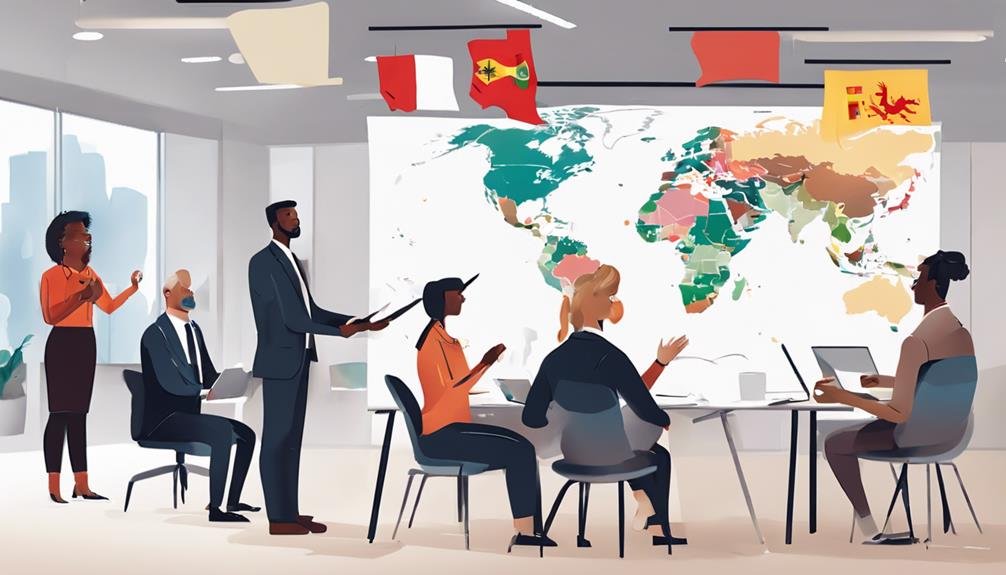Cross-cultural training becomes indispensable when considering the complexities of today’s global business environment. It’s about understanding different customs and fostering effective communication and collaboration in diverse settings. You might wonder how such training can transform your team dynamics and drive performance. What key components should be included, and how can you guarantee the training leaves a lasting impact? By exploring these questions, you’ll uncover strategies to make a real difference in your organization.
Key Takeaways
- Enhances awareness and sensitivity to cultural differences, improving workplace harmony.
- Utilizes interactive methods for engaging and effective learning experiences.
- Develops skills in communication, conflict resolution, and empathy.
- Customizes training to address specific cultural nuances and global workforce dynamics.
- Integrates ongoing support for continuous adaptation and learning.
Importance of Cross-Cultural Training

Why is cross-cultural training so vital in today’s globalized workplace? It enhances your awareness, sensitivity, and communication skills, which are fundamental in a multicultural workforce. When you’re equipped to understand and respect different cultural backgrounds, you can adapt more effectively, especially in virtual workplaces where cultural nuances can easily be misinterpreted.
Cross-cultural training fosters empathy and effective teamwork by helping you see things from different perspectives. This understanding is essential for building inclusive behavior, which has been shown to boost company performance and financial success. Companies that invest in such training programs often find their employees work better together, creating a more harmonious and productive environment.
Moreover, training programs focusing on cultural differences can greatly reduce frustration and stress. By addressing these challenges head-on, you’ll find it easier to navigate and thrive in diverse settings.
Interactive and engaging training ensures you retain and apply what you’ve learned. Cross-cultural training isn’t just about learning facts; it’s about transforming your approach to working with others, making you a more effective and empathetic team member.
Components of Effective Training
Building on the significance of cross-cultural training, let’s explore what makes such programs effective.
An effective cross-cultural training program addresses the frustration and stress of cultural differences in the workplace. Incorporating interactive and engaging learning methods is vital. These methods keep participants involved and make the training more impactful.
Focusing on skill development, such as communication and conflict resolution, is also necessary. Honing these skills better equips employees to navigate diverse work environments.
Open communication is another key component. It creates a continuous learning environment and promotes inclusivity, making everyone feel heard and respected.
Empowering employees to adapt is a significant goal of any effective cross-cultural training. When employees understand and respect different cultures, they foster empathy and understanding within the team, leading to a more cohesive and productive work environment.
Strategies for Building Awareness

To effectively build awareness in cross-cultural training, initiating by recognizing and understanding diverse cultural behaviors is necessary. When creating training programs, stereotypes and biases should be avoided. Instead, focus on genuine cultural differences and how these can impact cross-cultural communication. By doing this, you create a foundation of respect and openness.
Adapting your behavior is vital. Clear communication and reducing potential conflicts are key aspects of building awareness.
For instance, grasping that direct communication is valued in some cultures while indirect communication is preferred in others can help you navigate conversations more effectively. This adaptability in your cross-cultural communication strategies can greatly enhance the training experience.
Control over your actions is another important strategy. Gaining control over your reactions and responses makes you more adaptable in different cultural settings. This improves your awareness and sets a positive example for others in the training programs.
Ultimately, building awareness leads to improved teamwork and productivity. Collaboration becomes smoother and more efficient when everyone understands and respects cultural differences. Implement these strategies, and you’ll notice an improvement in your cross-cultural training outcomes.
Interactive Learning Methods
Interactive learning methods are essential in cross-cultural training because they greatly enhance engagement and effectiveness. Incorporating interactive learning methods guarantees that participants aren’t just passive listeners but active learners when involved in culture training. These methods, such as role-playing exercises, allow individuals to navigate cultural differences in practical scenarios. This hands-on approach is crucial for understanding and implementing cultural nuances effectively.
Engagement is key to the success of cultural training. When employees are actively engaged, they’re more likely to develop cultural awareness and sensitivity. Interactive methods foster better communication skills and a deeper understanding of diverse perspectives, which are vital in today’s globalized workplace.
Consider these benefits of interactive learning methods:
- Enhanced Engagement: Participants are more likely to retain information when actively involved.
- Practical Skills Development: Role-playing and other exercises help the practical application of cultural knowledge.
- Improved Communication: Interactive methods improve the ability to communicate across cultures.
- Diverse Perspectives: These methods encourage understanding and respect for different cultural viewpoints.
Incorporating these interactive learning methods into your culture training can transform the learning experience, making it more effective and impactful for everyone involved.
Ensuring Lasting Impact

Achieving a lasting impact in cross-cultural training hinges on a well-balanced approach that integrates interpersonal skills, effective communication, and conflict resolution strategies. Empowering employees to adapt to global workforce dynamics would be best, maintaining the sustainability of your cross-cultural training programs. To bridge cultural gaps effectively, focus on empathy, adaptability, and interpersonal skills.
Providing your team with tools for quick adaptation to cultural differences is essential for long-term success. Equip employees with the skills to thrive in diverse work environments, contributing to the lasting success of your cross-cultural training efforts. Here’s a practical breakdown to guide you:
| Key Focus | Strategies | Outcome |
|---|---|---|
| Interpersonal Skills | Focus on empathy and adaptability | Creates an effective cross-cultural team |
| Effective Communication | Implement active listening techniques | Bridges cultural gaps |
| Conflict Resolution | Train in negotiation and mediation | Ensures smooth teamwork |
Effective Training Programs
Building on the foundation of ensuring lasting impact, effective training programs are the cornerstone of successful cross-cultural training initiatives. It would be best to have programs that enhance communication and collaboration to address the workplace’s subtle cultural differences. Effective training will cater to the specific training needs of your organization, ensuring that employees understand differences in trust-building and criticism delivery. This understanding is pivotal for fostering a culture of respect and effective conflict resolution within your team.
To make your training programs more impactful, consider these key elements:
- Interactive Methods: Engage employees through interactive sessions to combat indifference and make learning more engaging.
- Practical Tools: Provide tools for quick cultural adaptation, helping employees develop global talent.
- Real-Life Scenarios: Use real-life scenarios to highlight the importance of cultural sensitivity in everyday workplace situations.
- Empathy Building: Foster empathy by encouraging employees to step into each other’s shoes and understand diverse perspectives.
U.S. companies have increasingly recognized the significance of such programs, focusing on improving workplace communication and cultural sensitivity. By integrating these elements, you can create training programs that meet your organization’s training needs and build a more cohesive and culturally aware team ready for effective conflict resolution.
Developing Training Strategies

Effective training strategies are essential for any cross-cultural training business aiming to bridge cultural gaps in the workplace. You must thoroughly understand the subtle cultural issues to develop impactful training solutions. Recognizing how different cultures approach trust-building and delivering criticism can significantly improve workplace communication and collaboration.
Start by tailoring your training programs to address specific cultural nuances. For instance, U.S. companies have enhanced workplace communication to boost U.S. sensitivity. You should follow suit by creating engaging and interactive training modules that captivate your global workforce and mitigate employee indifference.
Incorporate global dexterity training into your strategy. This will equip employees with the skills they need to adapt to diverse environments effectively. It will also teach them about cultural differences and provide practical tools to navigate these differences in real-world scenarios.
Case Studies and Best Practices
Examining case studies and best practices, you’ll discover how leading companies like Boeing, SAP, and Iberdrola USA have successfully implemented cross-cultural training programs. Boeing leverages internal and external trainers to boost cultural awareness among its workforce, ensuring a balanced perspective in its training approach.
SAP customizes its cross-cultural training to fit specific locations and employee needs, tailoring each program to maximize relevance and impact.
Meanwhile, Iberdrola USA’s cultural sensitivity program supports its international employees, helping them adapt more smoothly to new environments.
Key Takeaways:
- Boeing: Utilizes a mix of internal and external trainers for thorough cultural awareness.
- SAP: Customizes training based on specific location and employee needs.
- Iberdrola USA: Implements cultural sensitivity programs for international employees.
- In-house Training: Essential for preventing legal risks and stereotyping.
Adopting a Berlitz cultural approach can help your organization address its specific needs while focusing strongly on cultural unity and differentiation. By learning from these best practices, you can create a robust cross-cultural training program that enhances employee understanding and fosters a more inclusive and respectful workplace.
Additional Resources and Insights

To improve your cross-culture training programs, leverage SHRM’s research on combining AI and HR for better compliance practices.
A global mindset is essential for communication skills across diverse environments.
Additionally, guarantee your training helps employees retain their cultural identities while adapting to global work settings.
Combining AI and HR
Leveraging AI in HR can greatly enhance the efficiency of programs. By combining artificial intelligence with human oversight, you address employees’ specific needs in a diverse workplace. This integration guarantees that your training will be more personalized, effective, and compliant with global standards.
SHRM research on Global Diversity and Inclusion highlights the importance of incorporating technology and human intelligence in your cultural training initiatives. AI can handle vast amounts of data, identifying A.I.atterns and A.I…making preA.I.ctions that a human might miss. This allows you to:
- Tailor training modules to individual employee needs, ensuring relevance and engagement.
- Monitor and evaluate progress in real-time, adjusting training plans as necessary.
- Facilitate effective communication by providing translation and cultural context tools.
- Guarantee compliance with global diversity standards, minimizing the risk of cultural insensitivity.
AI tools can help foster a culturally positive work environment, but critical AI of human intelligence can’t be overlooked. Human oversight assures that the nuances of cultural differentiation are respected and maintained, making your cross-cultural training programs truly effective.
Developing Global Mindset
Integrating AI into HR practices sets the stage A.I. or fosH.R.ring aA.I.lobal H.R.ndset A.I.thin yH.R.r workA.I.rce. TH.R.s mindset is essential for thriving in today’s interconnected world. By understanding diverse cultural perspectives, your team will recognize cultural nuances, communication styles, and behaviors, promoting effective cross-cultural interactions.
To develop this Global Mindset, focus on enhancing skills and knowledge through targeted training programs. These programs should highlight the importance of empathy and adaptability, enabling employees to navigate and respect cultural differences. Doing so will create a more inclusive corporate culture where innovative ideas can flourish.
Organizations with a global mindset can collaborate better and succeed in international business relationships. The ability to appreciate and adapt to cultural diversities drives worldwide growth and provides a competitive edge in the global marketplace. Fostering empathy and adaptability helps employees connect more deeply with international partners, promoting trust and collaboration.
Ultimately, investing in developing a Global Mindset ensures your workforce is prepared to meet the challenges and opportunities of a global economy. By prioritizing cross-cultural competence, you position your organization for sustained success and growth on the international stage.
Enhancing Compliance Practices
Developing strong compliance practices in cross-cultural training programs necessitates a strategic mix of artificial intelligence and human oversight. Utilizing AI can help you manage large volumes of data and monitor compliA.I.ce trends, but don’t underestimate the crucial role of human intelligence in navigating the intricacies of diverse cultures. SHRM research on Global Diversity and Inclusion underscores that grasping and adapting to varied cultural norms is crucial for every employee.
To enhance compliance practices, consider the following strategies:
- Integrate AI tools: Utilize AI. I to automate ROA.I compliance tasksA.I. data and idA.I.tiA.I. potential issueA.I.
- Promote Global Mindset: Educate employees to comprehend and appreciate diverse cultural norms, nurturing a more inclusive workplace.
- Cultural Distinction Training: Guarantee that training programs uphold employees’ cultural identities while advancing inclusivity.
- Human Oversight: Employ human intelligence to interpret intricate cultural nuances and make well-informed decisions.
Conclusion
Investing in cross-cultural training is vital for your business’s success in today’s diverse world. Enhancing awareness, sensitivity, and communication skills will foster empathy, teamwork, and inclusive behavior. Effective training programs and interactive learning methods guarantee lasting impact, helping employees adapt to multicultural environments seamlessly. Embrace these strategies to boost collaboration, reduce misunderstandings, and enhance your company’s performance. Remember, a well-prepared team is essential to thriving in a globalized market.
FAQs
1. What Is an Example of a Cross-Cultural Training Program?
The Global Competence Certificate (GCC) is an example of a cross-cultural training program. Through interactive modules, you’ll understand the importance of cross-cultural training, experience the benefits of cultural immersion, and learn strategies for effective training sessions.
2. What Companies Provide Cross-Cultural Training?
You might want to explore top providers like Berlitz, Aperian Global, RW3 CultureWizard, Kozai Group, and GCC. These companies address cultural differences in diverse business environments to offer benefits like improved communication and inclusivity.
3. What Is Cross Training Business?
In cross-training business, you focus on developing employees’ diverse skills to handle multiple roles. Benefits include flexibility and efficiency. Challenges arise with mastery. Strategies and best practices guarantee a positive impact on your global workforce and overall performance.
4. What Is an Example of a Cross-Cultural Business?
You’d find an example of a cross-cultural business in a company like Boeing. They emphasize cultural sensitivity and global communication, using diversity training to foster intercultural competence and cross-cultural collaboration, enhancing international business relations.

